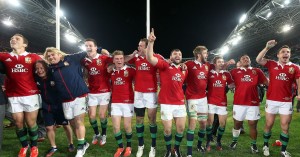British and Irish Lions – Then and Now
 The British and Irish Lions is a rugby union team that comprises players from any of the Home Nations, i.e. England, Ireland, Scotland or Wales. With their 2017 New Zealand tour coming up, we’ve decided to take a walk down memory lane and uncover some of the key moments in this Test side’s history.
The British and Irish Lions is a rugby union team that comprises players from any of the Home Nations, i.e. England, Ireland, Scotland or Wales. With their 2017 New Zealand tour coming up, we’ve decided to take a walk down memory lane and uncover some of the key moments in this Test side’s history.
1950 – The team became known as the British Lions rather than the British Isles. This was the first time in 14 years that the Lions had toured and lasted nearly 8 months.
1955 – During the 1955 season, the Lions went up against the South African Springboks in a rare shared series. This year, the Lions made history by featuring Irish winger Tony O’Reilly, the team’s youngest test player at the age of 19 years and 91 days.
1959 – The Australian tour as straightforward from the beginning, but since the League was a far bigger game than the Union games; the team lost the series to New Zealand.
1962 – During this tour the Lions visited Namibia, Zimbabwe and Kenya after losing to the South African Springboks.
1966 – This was the last year the Lions played against two nations on one trip, namely Australia and New Zealand.
1968 – This was a disappointing tour for the Lions. First, they lost to South Africa, and then many of its members left the team to play Rugby League professionally once they returned home.
1971 – This was a glorious year for the Lions as Coach Carwin James inspired the team to their only series win in New Zealand.
1974 – This was one of the most successful tours in Lions’ history, but a disallowed Fergus Slattery try in the final minute resulted in a loss for the side.
1977 – The team was plagued with injuries and homesickness during the 1977 tour. Things got so bad that the Lions even lost to Fiji on their way home.
1980 – Not much happened during this tour. Irish fly-half Tony Ward show a brief moment of brilliance while protests over the team playing in South Africa during Apartheid plagued the series.
1983 – Another bad tour for the Lions, with many wondering if it would be the end of the concept, especially since the Rugby World Cup was becoming the more popular competition.
1989 – This was the first time the Lions exclusively toured Australia. Although the Lions took the honours, many believed that the Wallabies should have won.
1993 – A close test match series was marred by a disastrous performance and defeats against Auckland, Waikato, Otago and Hawke’s Bay.
1997 – During this tour, the Lions were up against the World Champions and were joined by Alan Tait and Scott Gibbs.
2001 – This was the first year the side toured as the British and Irish Lions and was again up against the World Champions.
2005 – The side boasted a 44-man squad, which was the largest the series had seen. Captain Brian O’Driscoll was injured without the first two minutes of the first test, being replaced by Gareth Thomas.
2009 – The second test in Pretoria, South Africa, was definitely one of the most exciting to come out of the series. In a game steeped in edge-of-your-seat action, it culminated in the referee failing to send off Springbok Schalke Burger for eye gorging, which cost the Lions the title.
2013 – This year, the Lions enjoyed their first series victory since 1997.
Many rugby betting sites offer the latest odds on who will win the 2017 series, set to be the most exciting and action-packed tour yet. The 2017 New Zealand Tour kicks off on the 3rd of June as the Lions take on the New Zealand Provincial Barbarians in Rotorua, and ends on the 8th July in Auckland.